10 Enchanting Garden Pond Ideas to Transform Your Outdoor Space
1. Natural Wildlife Pond
Create a wildlife-friendly pond with gently sloping edges and native aquatic plants like water lilies and rushes. These natural havens attract beneficial creatures such as frogs, dragonflies, and birds while requiring minimal maintenance. Position your wildlife pond where it receives about 6 hours of sunlight daily but has some shade to prevent excessive algae growth.
2. Koi Pond with Viewing Deck
Design a deeper pond (at least 4 feet) specifically for colorful koi fish, complete with proper filtration systems and a wooden deck that extends partially over the water. This creates a perfect viewing spot where you can relax and observe these graceful swimmers from above. Include underwater lighting to enjoy the spectacle even after sunset.
3. Container Water Garden
Transform ordinary containers like half whiskey barrels, large ceramic pots, or metal tubs into charming mini ponds. This space-saving solution works perfectly for patios, balconies, or small gardens. Add compact water plants, a small fountain pump, and perhaps tiny water lilies to create an enchanting water feature without extensive excavation.
4. Formal Geometric Pond
Incorporate a structured rectangular or circular pond with clean lines and symmetrical design to complement modern or traditional garden styles. Edge the pond with uniform stonework or pavers and add simple water jets or a centered statue for classic elegance. This architectural approach creates a striking focal point in well-manicured landscapes.
5. Stream and Waterfall Combination
Build a ever-changing water feature that combines a meandering stream with multiple small waterfalls flowing into a collection pond. Use varying sizes of river rocks and boulders to create natural-looking cascades with the soothing sound of flowing water. This multi-level design adds visual interest and masks ambient noise from nearby streets.
6. Raised Pond with Seating Wall
Construct an elevated pond surrounded by a built-in seating wall that invites visitors to sit and enjoy the water up close. This design eliminates the need to bend down to view fish or water plants and creates a natural gathering spot in your garden. The raised structure also helps protect the pond from run-off and falling debris.
7. Reflecting Pool
Install a simple, shallow pool with a dark bottom liner to create a mirror-like surface that reflects the sky, surrounding plants, and architecture. This minimalist approach focuses on the beauty of reflection rather than aquatic life, making maintenance easier while still delivering dramatic visual impact. Position near colorful foliage for stunning reflections.
8. Bog Garden Pond
Develop a specialized wetland pond area with saturated soil and moisture-loving plants like pitcher plants, iris, and marsh marigolds. This unique network creates habitat for specialized wildlife while filtering water naturally. The shallow, marshy edges blend seamlessly into your garden while supporting biodiversity.
9. Japanese-Inspired Zen Pond
Design a tranquil pond following Japanese garden principles with carefully placed rocks, minimal plantings, and perhaps a small wooden bridge or stone lantern. Include elements like bamboo water spouts (shishi-odoshi) or stone basins (tsukubai) to enhance the meditative atmosphere. This style emphasizes harmony and contemplation.
10. Illuminated Night Pond
Focus on creating a pond that comes alive after dark with strategically placed underwater LED lights, floating solar orbs, and illuminated fountains. Choose color-changing options to transform your evening garden into a magical space. Add pathway lighting around the pond’s perimeter for safety and enhanced nighttime enjoyment.
Creating a Natural Oasis: Wildlife-Friendly Pond Designs
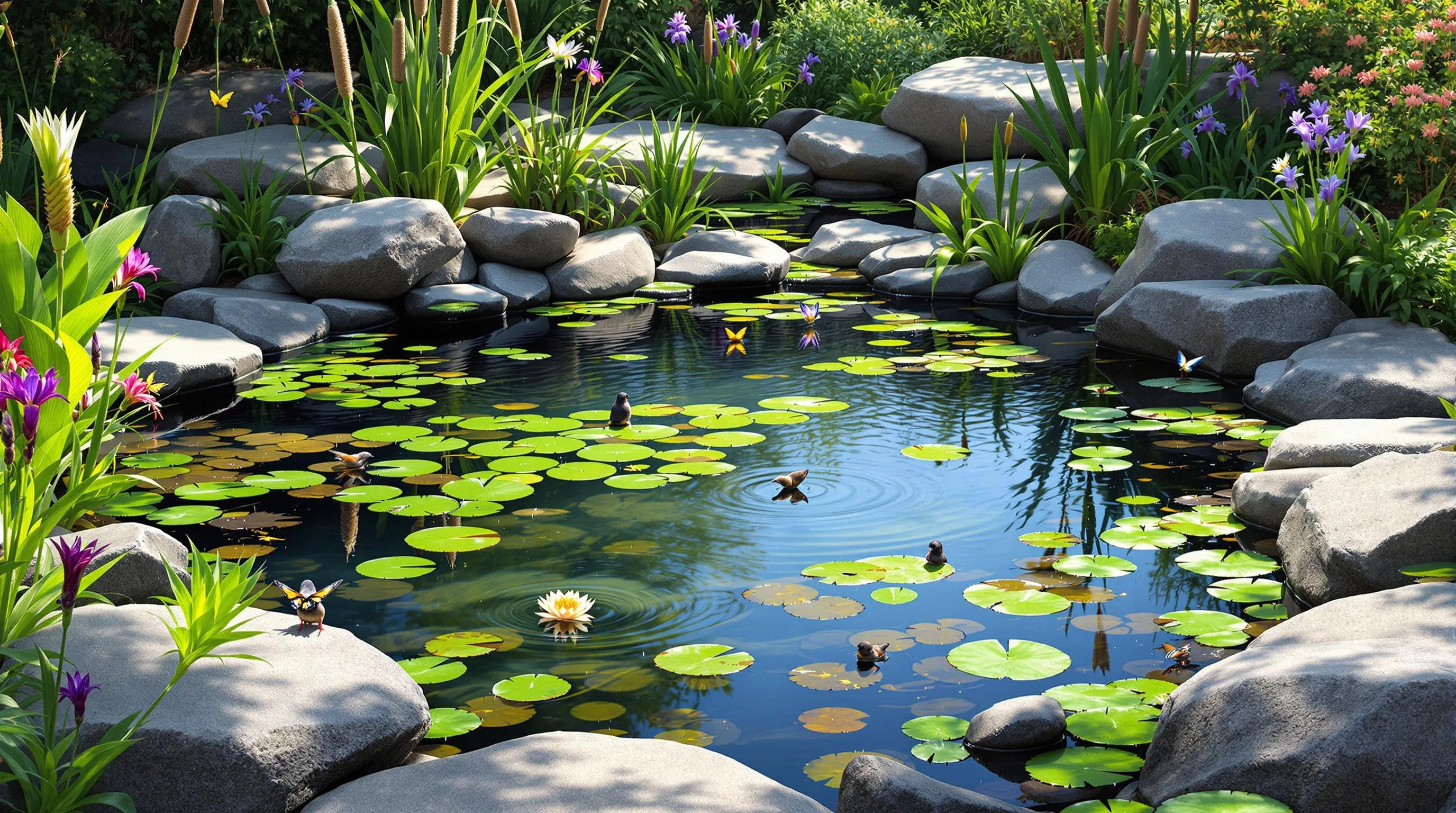
Wildlife-friendly pond designs transform your garden into a thriving network while creating a stunning focal point. These natural oases support local biodiversity and require less maintenance than formal ponds, making them both beautiful and practical additions to any outdoor space.
Attracting Local Birds and Beneficial Insects
Design your pond with gently sloping sides to create safe access points for birds to bathe and drink. Include varying water depths—shallow margins (1-2 inches) for insects and deeper sections (18-24 inches) for overwintering creatures. Position flat rocks around the edges as landing spots for butterflies and dragonflies, which help control mosquito populations. Install a simple bubbler or small fountain to create moving water that attracts more birds while discouraging mosquito breeding. Leave some fallen leaves and natural debris nearby to provide habitat for beneficial insects like ladybugs and ground beetles that will help maintain the ecological balance of your garden pond.
Incorporating Native Aquatic Plants
Native aquatic plants are the foundation of any wildlife-friendly pond, providing oxygen, filtering water, and creating habitat structures. Include emergent plants like cattails and irises along the margins, floating plants such as water lilies to provide shade (covering 50-60% of the water surface), and submerged oxygenators like hornwort beneath the surface. Choose species native to your region—they’ll adapt better to local conditions, require less maintenance, and provide familiar food sources for local wildlife. Create planting zones at different depths to support diverse plant communities: bog plants at the edges, marginal plants in shallow water, and deep-water plants in the center. This layered approach mimics natural pond ecosystems and maximizes biodiversity while keeping your pond naturally balanced and healthy.
Container Ponds: Perfect Solutions for Small Gardens

Container ponds offer an accessible way to enjoy water features without committing to a full-sized garden pond. These compact alternatives bring the tranquility of water to patios, balconies, and small garden spaces while requiring minimal setup and maintenance.
Repurposed Items as Creative Containers
Transform everyday objects into charming water features with repurposed container ponds. Old whiskey barrels, ceramic pots, galvanized tubs, and even vintage clawfoot bathtubs make excellent unconventional vessels for mini ponds. Wooden half-barrels provide a rustic aesthetic while being naturally watertight after swelling. Metal containers like zinc tubs or washbasins create an industrial-chic look but may need sealing to prevent rust. For an eco-friendly approach, consider salvaged sinks, old wheelbarrows, or ceramic birdbaths. These repurposed containers not only reduce waste but also add character and history to your garden space, serving as unique focal points that reflect your personal style.
Easy-to-Maintain Mini Ecosystems
Container ponds create self-sustaining ecosystems when properly balanced with the right elements. Include a small solar-powered pump to keep water moving, preventing mosquito breeding and maintaining oxygen levels. Select dwarf aquatic plants like miniature water lilies, water lettuce, and hornwort to provide natural filtration without overwhelming the space. Add small stones or gravel at the bottom to harbor beneficial bacteria that break down waste. These mini ecosystems typically require less maintenance than larger ponds—simply top off water levels during dry periods and remove debris occasionally. For added interest, incorporate tiny aquatic creatures like snails or small fish in larger containers, creating a complete microhabitat that brings life and movement to your small garden space.
Waterfall Features: Adding Movement and Sound
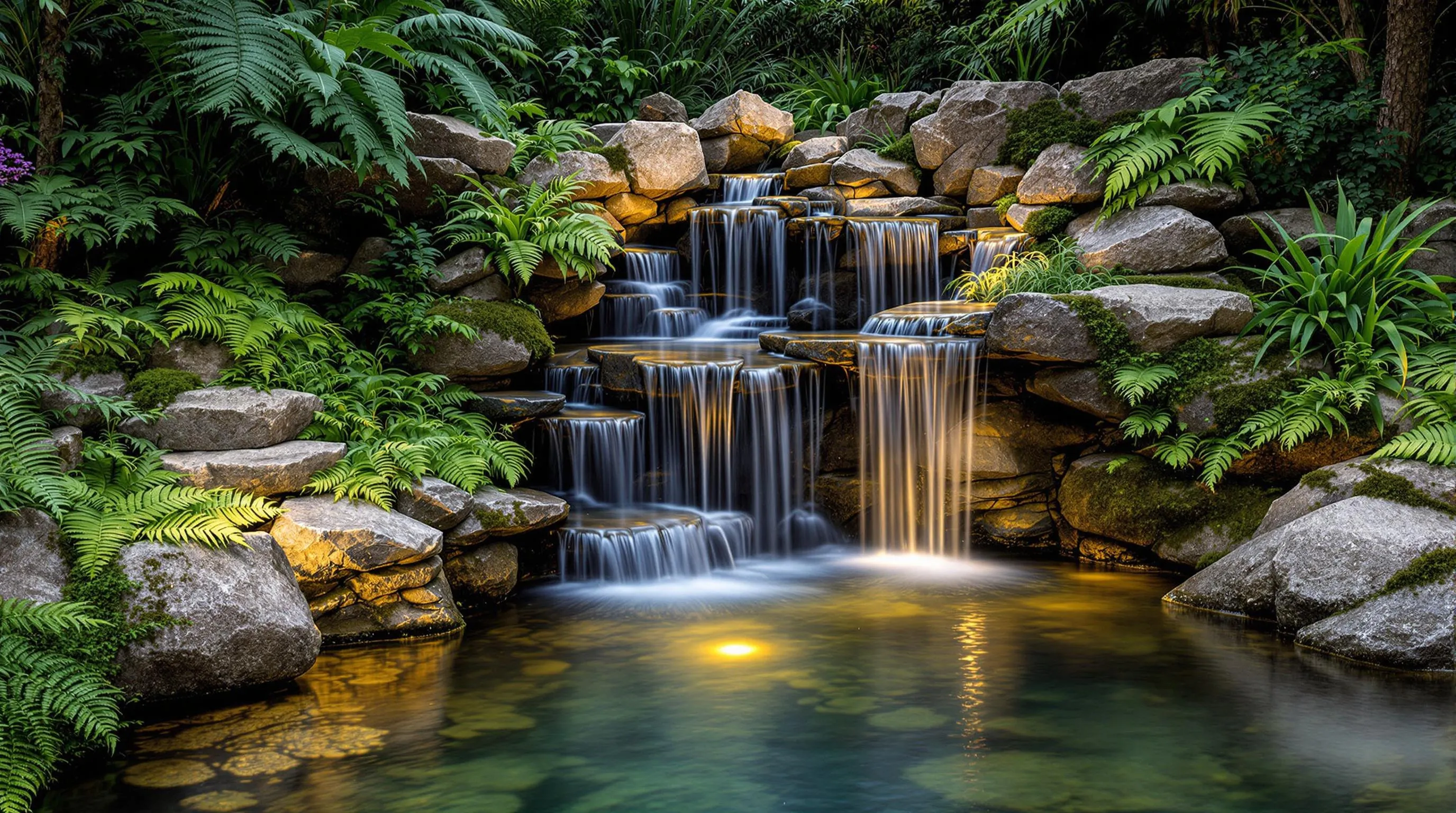
A waterfall feature transforms a static garden pond into a ever-changing focal point, captivating multiple senses with its soothing sounds and captivating movement. These flowing water elements create a natural ambiance that can mask unwanted noise while adding visual interest to your outdoor sanctuary.
Cascading Rock Formations
Cascading rock formations create a stunning natural waterfall effect that mimics mountain streams. Select weathered stones like slate, granite, or limestone in varying sizes to build a realistic structure that directs water flow while creating multiple mini-falls. Position larger, flatter rocks at the bottom to prevent splashing and erosion, while using smaller stones to fill gaps and stabilize the structure. For authenticity, arrange rocks in an asymmetrical pattern and incorporate pocket plants like ferns and mosses between stones. This design not only produces soothing babbling sounds but also oxygenates your pond water, benefiting aquatic life while serving as a striking visual anchor in your garden industry.
Multi-Level Water Flow Designs
Multi-level waterfall designs introduce dramatic vertical interest to your garden pond through stepped platforms that create sequential water drops. Incorporate three to five distinct levels with varying drop heights—shorter falls produce gentle trickling sounds while taller cascades generate more pronounced splashing effects. Control water flow by adjusting the width of each channel, using narrower sections for faster currents and wider platforms for calm pools where water can momentarily collect. These designs work particularly well on sloped landscapes, transforming challenging terrain into an asset. Add underwater lighting beneath each fall to create mesmerizing light-water interactions after dark, extending your pond’s visual appeal well into the evening hours.
Koi Ponds: Bringing Vibrant Life to Your Garden
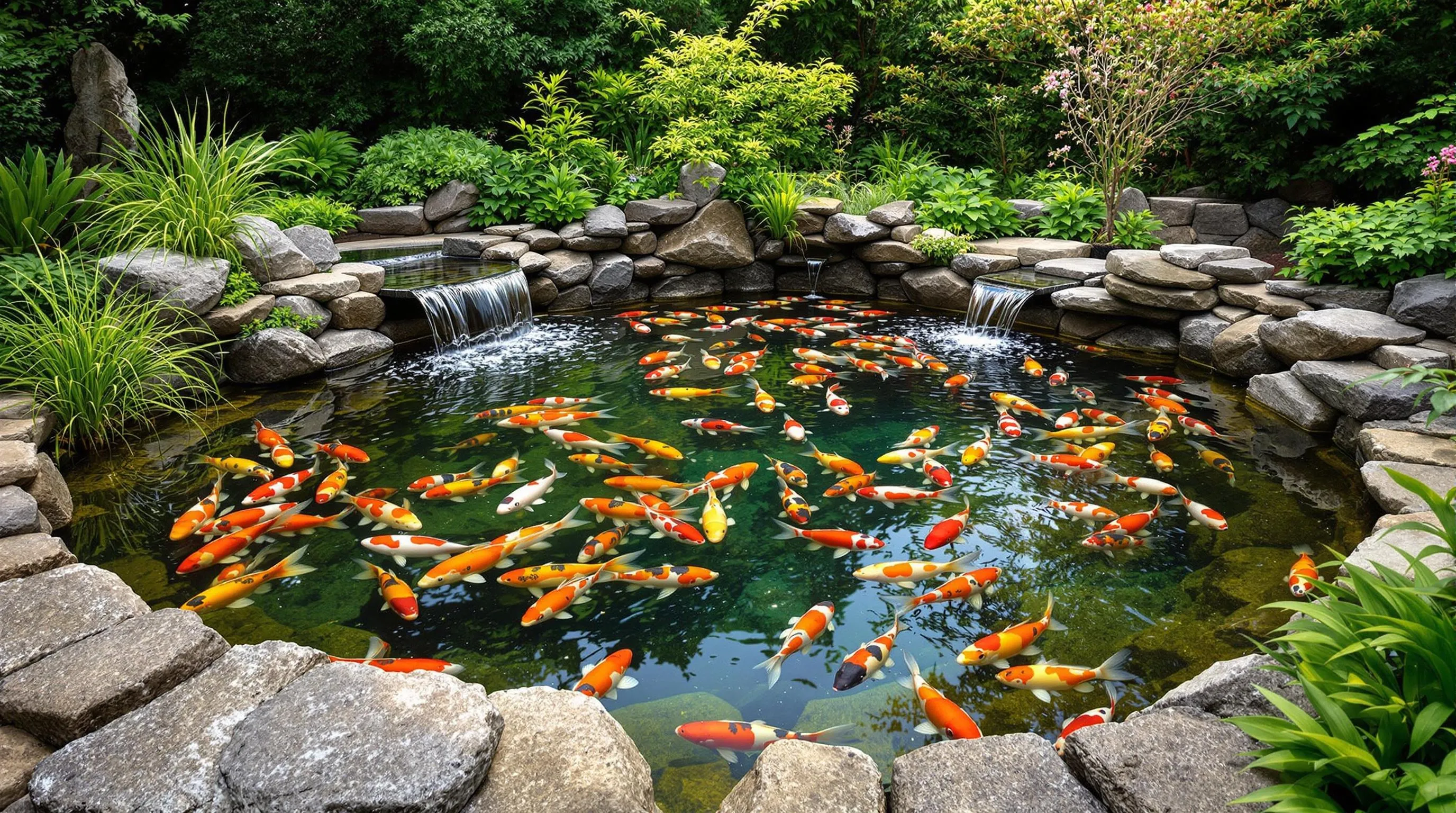
Koi ponds represent one of the most rewarding garden water features, offering a mesmerizing display of colorful fish that can become the centerpiece of your outdoor space. These ornamental ponds originated in Japan and have gained worldwide popularity for their elegant beauty and the meditative quality they bring to gardens.
Proper Depth and Filtration Requirements
Creating a successful koi pond requires careful planning with depth and filtration being paramount considerations. Your koi pond should be at least 3-4 feet deep to protect fish from predators and temperature fluctuations, with deeper zones of 5-6 feet recommended in colder climates to prevent freezing. A robust filtration system is essential for maintaining water quality, typically requiring both mechanical and biological filtration components. Install a pump that circulates the entire water volume at least once every hour to ensure proper oxygenation. For optimal koi health, maintain a pond size of at least 1,000 gallons—experts recommend 250 gallons per adult koi to prevent overcrowding and reduce maintenance demands. Adding bottom drains and skimmers will help remove debris before it decomposes and affects water quality, creating a healthier environment for your fish.
Seasonal Care for Healthy Fish
Koi pond maintenance varies significantly with the seasons, requiring attentive care throughout the year. In spring, gradually restart feeding as water temperatures consistently reach above 50°F, and perform a partial water change to refresh the network after winter dormancy. Summer demands vigilant monitoring of water quality with weekly testing for ammonia and nitrite levels, while ensuring water temperatures don’t exceed 85°F—consider adding shade plants or a pond canopy during extreme heat. Fall preparation is crucial as temperatures drop; reduce feeding frequency and switch to specialized cold-water food when temperatures fall below 65°F. Before winter sets in, remove fallen leaves with nets to prevent decomposition and excess nutrients. During winter in colder regions, maintain a small opening in the ice using a de-icer rather than breaking the surface, which can stress fish. A well-maintained aeration system operating year-round helps maintain oxygen levels regardless of season, supporting your koi’s health through temperature transitions.
Formal Reflection Ponds: Elegant Symmetrical Designs
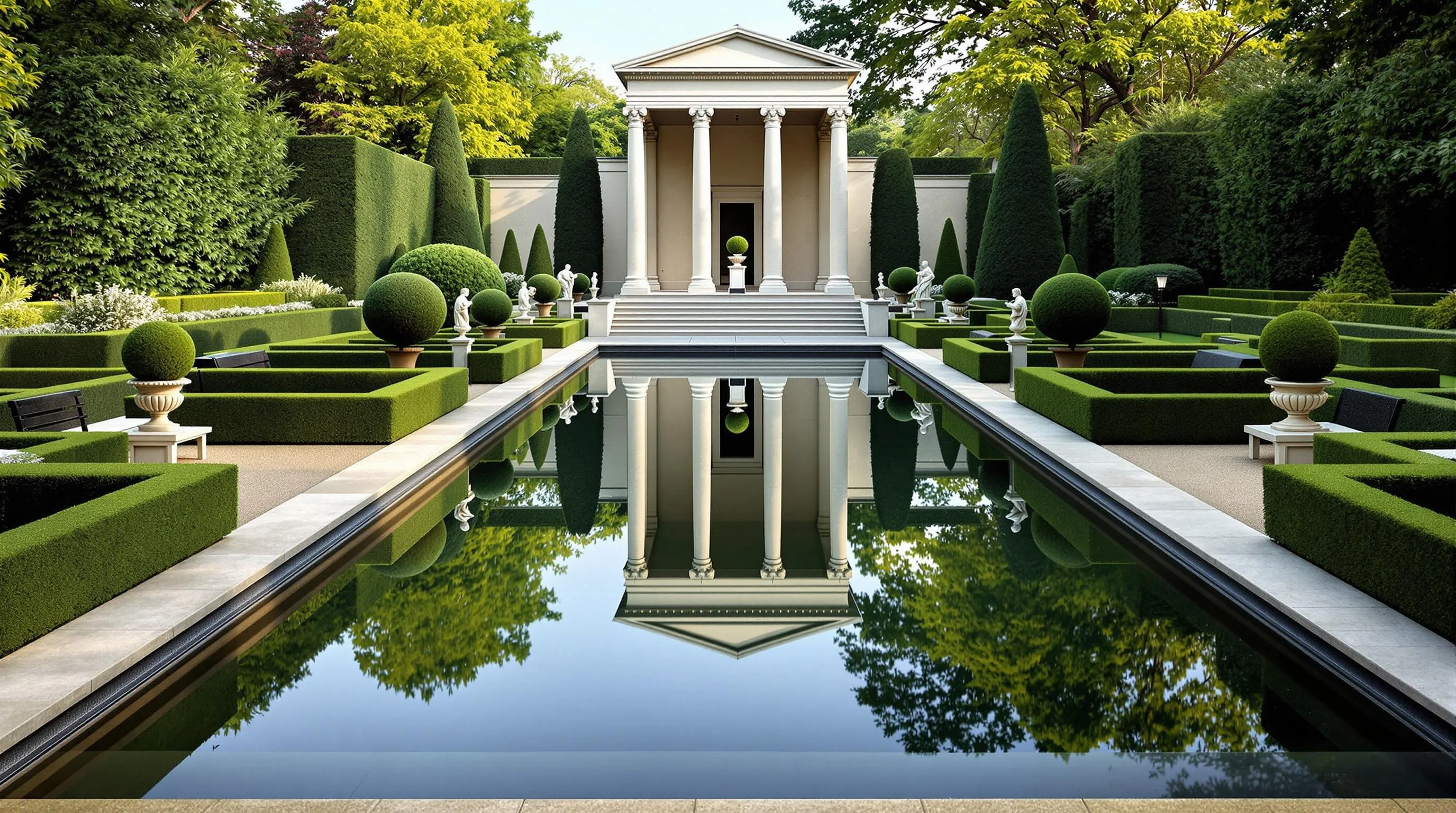
Formal reflection ponds bring a touch of classical elegance to your garden with their structured design and mirror-like surfaces. These sophisticated water features create a sense of order and harmony through perfect symmetry and precise proportions.
Geometric Shapes and Clean Edges
Formal reflection ponds showcase crisp geometric shapes that instantly elevate your garden’s design aesthetic. Rectangular and square ponds create a strong architectural statement, while circular and octagonal designs offer a softer yet equally refined appearance. The key to these ponds is their immaculate edges—often finished with cut stone coping, polished concrete, or formal brick work that creates a distinct boundary between water and industry. For maximum reflective quality, aim for a depth of at least 18-24 inches and install a dark liner that enhances the mirror effect. Many designers incorporate stone patterns in the surrounding hardscape that echo the pond’s shape, creating visual cohesion and reinforcing the formal design language.
Complementary Landscaping Elements
The beauty of formal reflection ponds lies in their harmonious integration with surrounding industry elements. Frame your pond with symmetrical plantings of boxwood hedges, topiary forms, or ornamental grasses that enhance the structured feel. Position matching garden ornaments like identical urns, sculptures, or formal benches on opposite sides of the pond to reinforce the symmetrical design. Consider adding classic architectural elements such as pergolas, pavilions, or columned structures that will be beautifully reflected in the still water. For a dramatic effect, install underwater lighting that illuminates the pond at night, creating a magical glow that transforms your garden after dark. The formal reflection pond truly shines when every element works together to create a cohesive, elegant outdoor space that feels both timeless and sophisticated.
Japanese-Inspired Garden Ponds
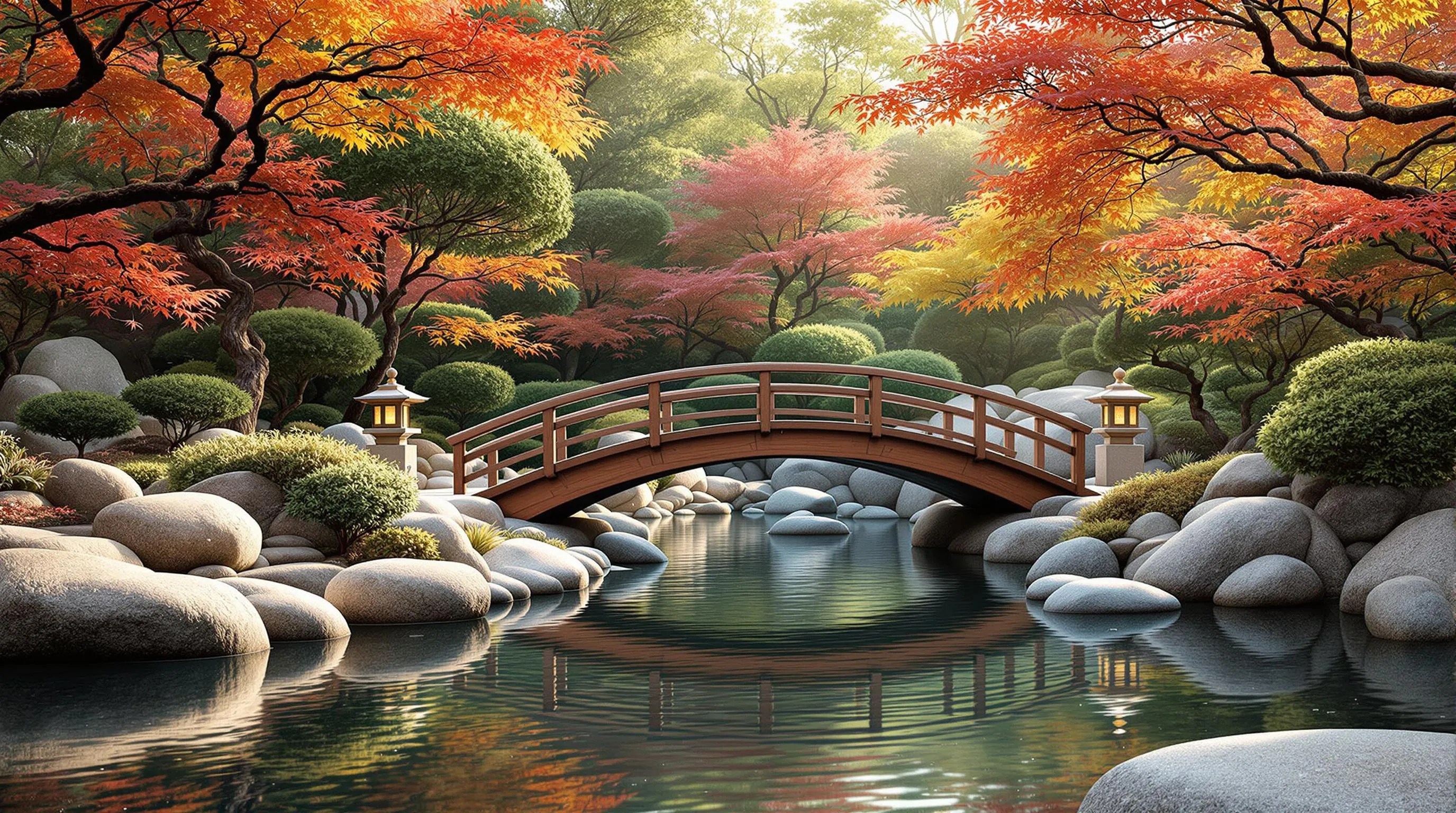
Japanese-inspired garden ponds embody tranquility and balance, transforming your outdoor space into a peaceful retreat. These thoughtfully designed water features emphasize harmony with nature and mindful simplicity that can bring a sense of calm to any garden industry.
Zen Elements and Minimalist Aesthetics
Japanese garden ponds embrace minimalist design principles that create visual serenity through careful restraint. Incorporate clean lines and uncluttered spaces around your pond to achieve authentic zen aesthetics. Choose smooth, rounded stones and position them asymmetrically along the pond edges to mimic natural formations. Add carefully pruned Japanese maples or cloud-pruned evergreens that provide seasonal interest without overwhelming the space. Integrate negative space (ma) intentionally around water features to allow visual breathing room and emphasize the beauty of simplicity. Traditional elements like stone lanterns and bamboo water spouts (shishi-odoshi) add authentic touches while maintaining the minimalist approach that defines Japanese garden design.
Traditional Bridge and Stone Features
A gently arching wooden bridge creates an iconic focal point in your Japanese-inspired pond design, symbolizing the journey between worlds. Select weathered stones of varying sizes and arrange them to appear as if naturally emerging from the water’s edge, creating miniature islands (iwakura) that represent mountains in the distance. Install stepping stones (tobi-ishi) that invite visitors to experience the pond from different vantage points while encouraging mindful movement through the space. Traditional stone basins (tsukubai) placed near the pond offer both practical and symbolic elements, originally designed for ritual cleansing before tea ceremonies. Enhance the authenticity with carefully positioned stone lanterns (tōrō) that provide subtle illumination and cast beautiful reflections on the water’s surface during evening hours.
Bog Gardens: Blending Pond and Plant Life
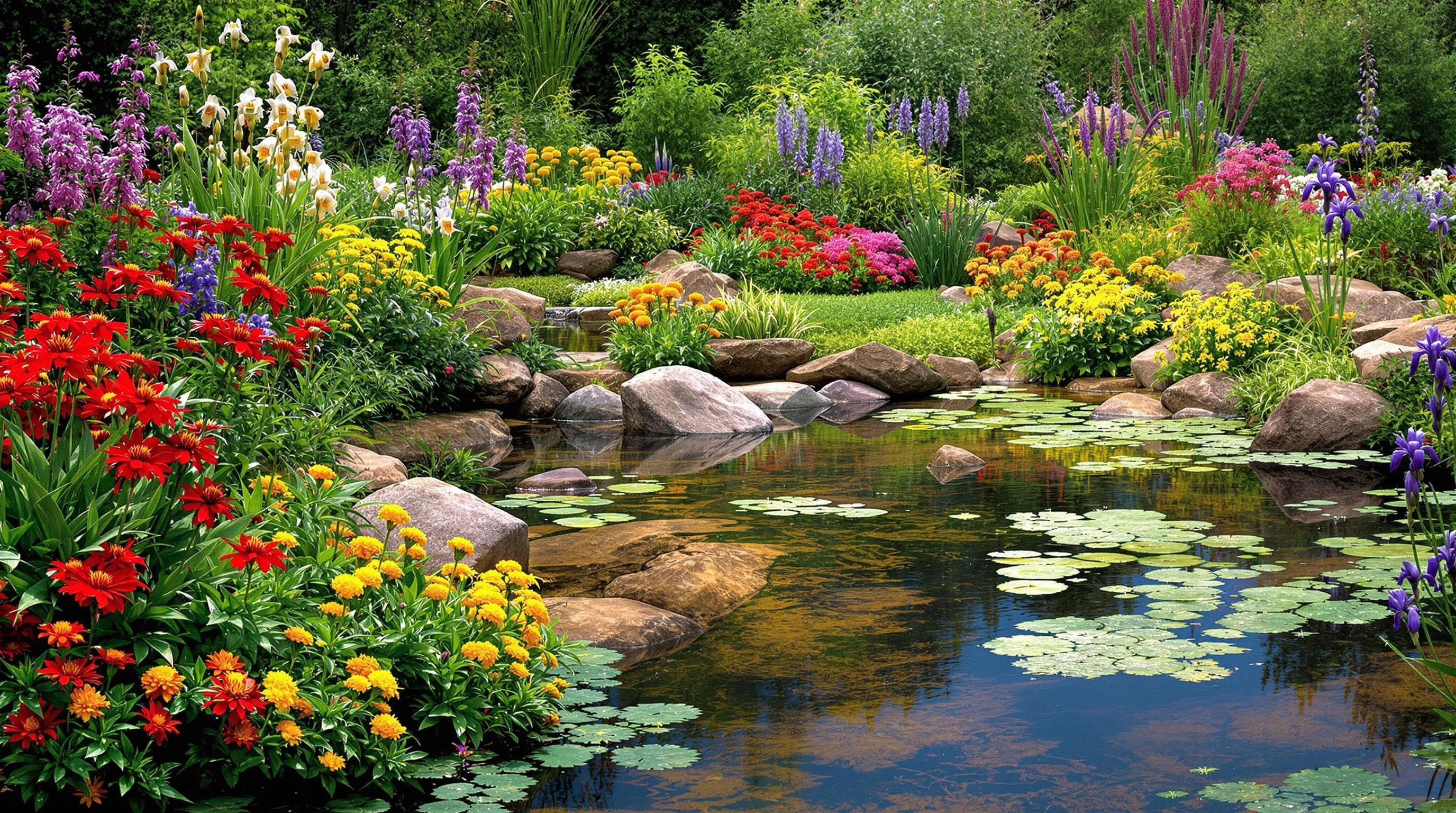
Bog gardens create a fascinating transition zone between water and land, offering a unique network that supports specialized plants and wildlife. These semi-aquatic areas feature constantly damp soil that mimics natural wetlands, providing an attractive extension to your garden pond.
Moisture-Loving Plant Selection
Choose plants specifically adapted to thrive in consistently wet conditions for your bog garden. Cardinal flower (Lobelia cardinalis) produces stunning red blooms that attract hummingbirds, while marsh marigold (Caltha palustris) offers cheerful yellow flowers in early spring. Incorporate ornamental sedges like Carex muskingumensis for textural interest and Japanese iris (Iris ensata) for dramatic vertical elements. Don’t overlook carnivorous plants such as pitcher plants (Sarracenia) and sundews (Drosera) which add fascinating botanical intrigue while helping control insects. Select native wetland species whenever possible as they’re already adapted to your local climate and provide essential habitat for native wildlife.
Creating Seamless Transitions
Design your bog garden with gradually sloping edges that blend naturally into the surrounding industry. Use moisture-retaining materials like coconut coir or specialized bog soil to maintain consistent dampness, and consider installing a slow-dripping irrigation system connected to your pond for effortless maintenance. Position stepping stones or small wooden walkways through your bog garden to allow closer observation without compacting the delicate soil. Create visual flow by echoing plants from your main garden in the bog area, using progressively more moisture-tolerant varieties as you approach the pond edge. This thoughtful transition not only looks more natural but also expands your planting palette while providing essential ecological benefits to your garden network.
Lighting Your Garden Pond: Day-to-Night Transformation
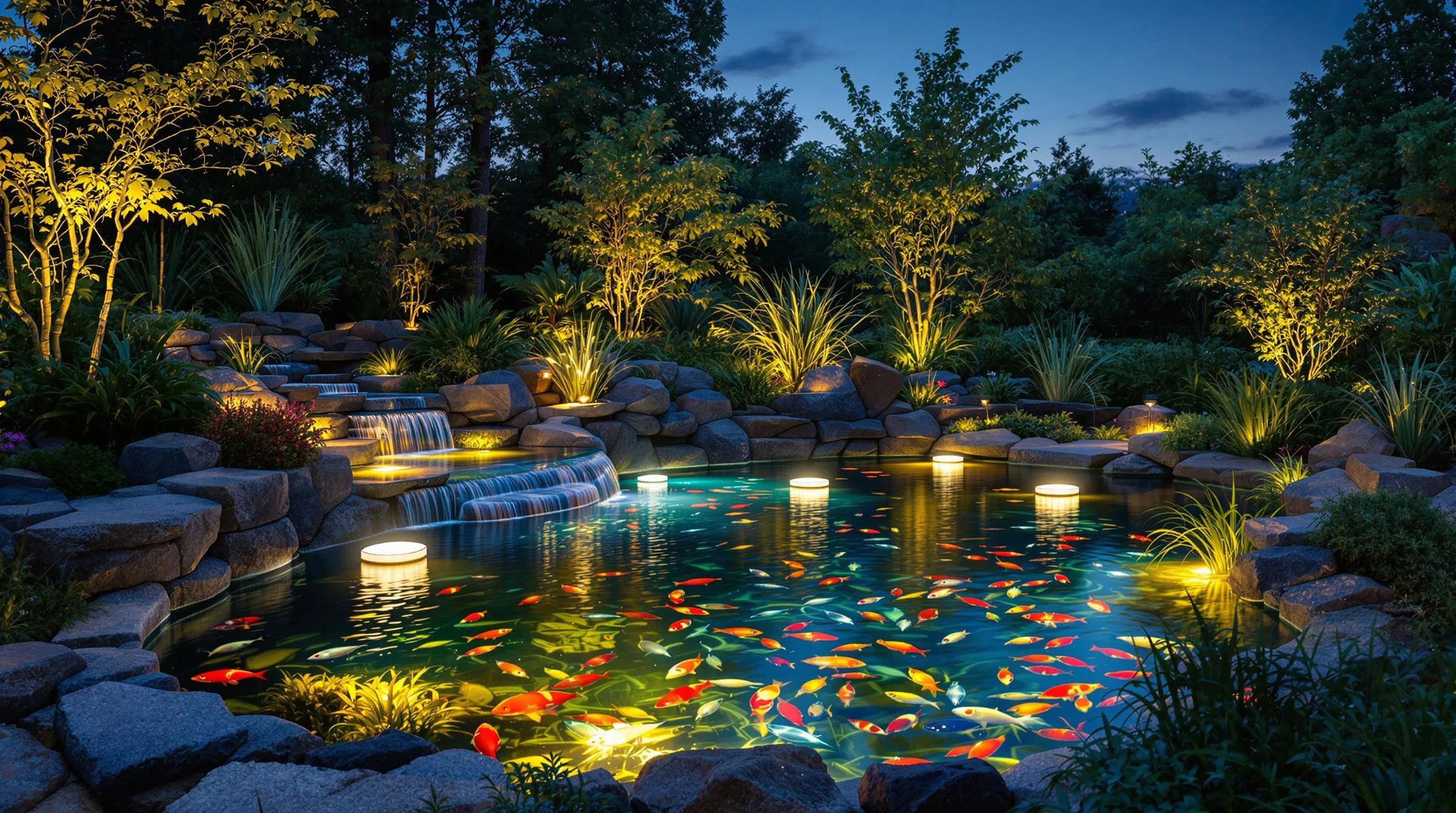
Your garden pond transforms dramatically from day to night with strategic lighting. Proper illumination not only highlights your pond’s best features but also extends your enjoyment into evening hours, creating a magical atmosphere that captivates guests and enhances your outdoor living space.
Solar-Powered Options for Sustainability
Solar-powered lighting offers an eco-friendly, cost-effective solution for illuminating your garden pond. These lights harness energy from the sun during daylight hours, automatically activating at dusk to create a subtle glow across your water feature. Position solar floating lights directly on the water’s surface for a starry effect, or install solar spotlights around the perimeter to highlight exact pond elements like fountains or decorative stones. Modern solar fixtures come with improved battery storage, providing up to 8-10 hours of illumination even after cloudy days. For maximum sustainability, choose systems with integrated light sensors and energy-efficient LED bulbs that reduce your carbon footprint while improving your pond’s nighttime appeal.
Underwater and Perimeter Lighting Techniques
Underwater lighting creates dramatic effects by illuminating your pond from within, showcasing fish, plants, and water movement. Install submersible LED lights at varying depths to create layers of illumination—position them behind rocks or plants for a diffused glow or aim them upward to capture rippling water patterns. For perimeter lighting, integrate weatherproof fixtures among surrounding plants and hardscaping to define the pond’s edges and improve safety. Combine different techniques like uplighting nearby trees, downlighting from overhead structures, and path lights along adjacent walkways for a comprehensive lighting design. Use warm white lights (2700-3000K) to enhance natural elements or colored lights for special occasions. With smart controllers, you can program lighting scenarios that transition throughout the evening, creating a continuously evolving outdoor display that transforms your pond into a nighttime centerpiece.
Low-Maintenance Pond Ideas for Busy Gardeners
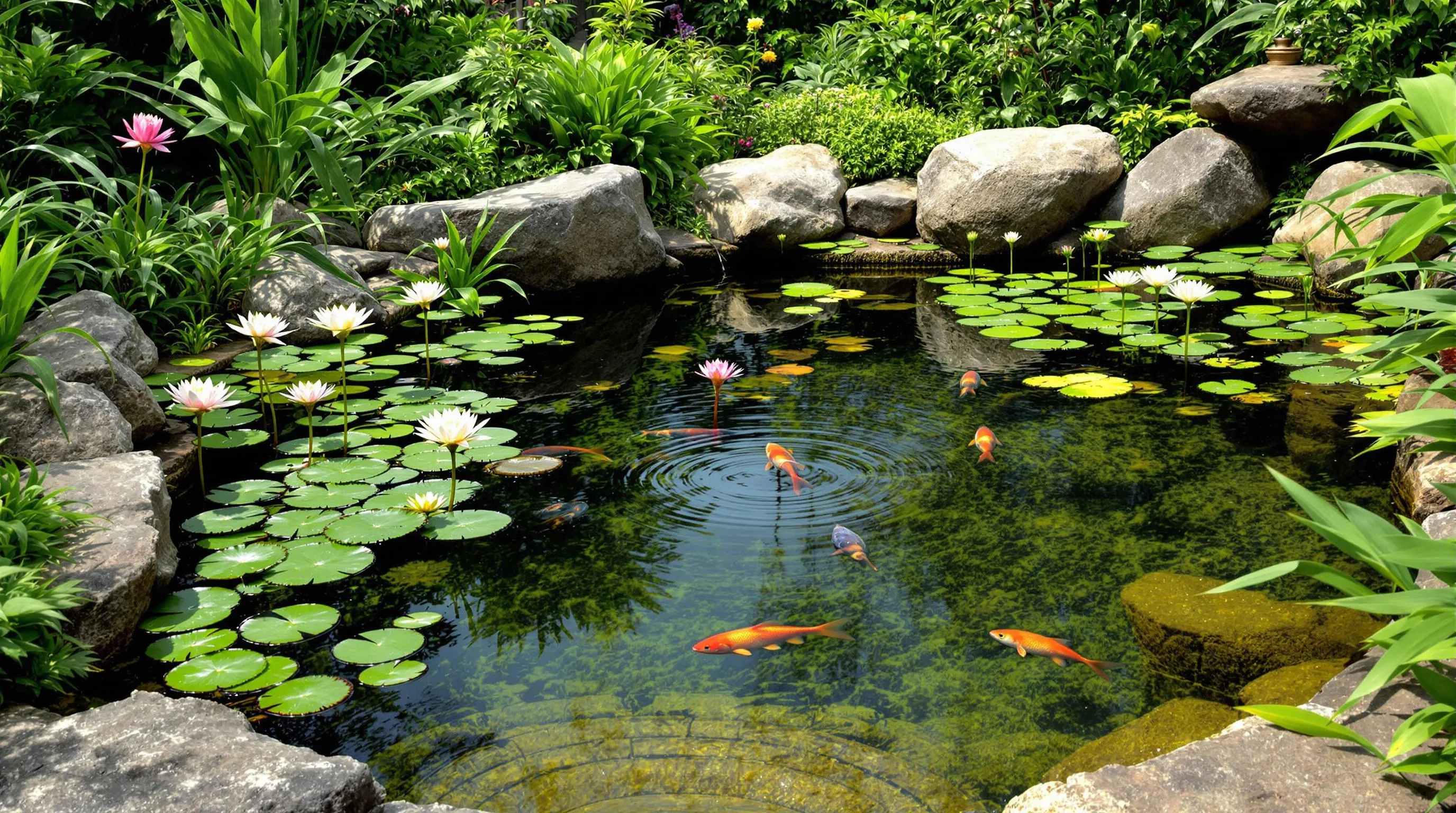
Creating a beautiful garden pond doesn’t have to mean hours of weekly maintenance. These low-maintenance pond designs are perfect for busy gardeners who want to enjoy the tranquility of water features without the time commitment.
Self-Sustaining Network Development
Developing a self-sustaining pond network is the key to reducing maintenance time while keeping your water feature healthy. Start by balancing your pond with the right proportions of submerged, floating, and marginal plants—aim for about 60% of the surface area covered with vegetation. Water lilies and hornwort act as natural filters, removing excess nutrients that would otherwise feed algae. Introduce beneficial bacteria products during spring startup to jumpstart the biological filtration process. For natural pest control, add a few mosquito fish or small native fish species that feed on larvae. Creating this balanced network means you’ll need to clean your pond just once or twice a year rather than monthly, saving you countless maintenance hours.
Time-Saving Design Elements
Incorporate smart design elements from the beginning to minimize future maintenance. Choose a pond location away from overhanging trees to prevent leaf buildup and excessive organic matter. Install a bottom drain system connected to your filter for easy sediment removal—this simple addition can eliminate the need for complete pond draining during cleanings. Add an automatic water level controller that connects to your water supply, maintaining consistent water levels without manual filling. Pre-filter systems capture debris before it enters the main pond, making maintenance as simple as emptying a basket weekly. A well-designed skimmer removes surface debris continuously, preventing it from sinking and decomposing. These thoughtful design choices can reduce your pond maintenance time from hours each week to just minutes.
Essential Maintenance Tips for Keeping Your Garden Pond Beautiful
Ready to take the plunge? Creating your dream garden pond is just the beginning of your water feature journey. From wildlife-friendly designs to elegant reflection pools and Japanese-inspired sanctuaries your perfect pond awaits.
Remember that thoughtful design choices like proper depth filtration systems and strategic lighting will save you time and effort in the long run. Whether you opt for a container pond on your patio or a grand koi pond with cascading waterfalls your water feature will become the heart of your outdoor space.
With the right balance of plants and regular seasonal care your pond will thrive as a self-sustaining network bringing tranquility movement and life to your garden for years to come. The perfect pond isn’t just about aesthetics—it’s about creating harmony between beauty and function in your personal outdoor sanctuary.





